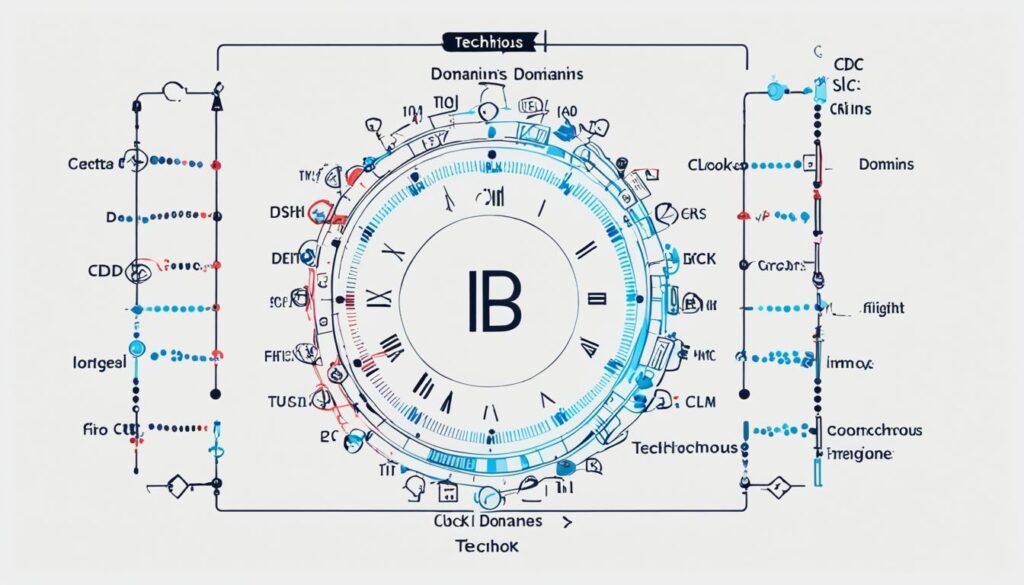In the world of digital electronics design, managing Clock Domain Crossing (CDC) issues is crucial to ensure reliable and efficient data transfer between different clock domains. One valuable technique that helps address these challenges is the use of Asynchronous FIFOs. These specialized memory buffers provide a reliable solution by decoupling the input and output clocks, allowing data to be transferred independently of the clock signal used in the system.
Asynchronous FIFOs operate using control logic to ensure the correct sequencing of read and write operations, even when the input and output clocks operate at different frequencies. This eliminates the risks associated with CDC, such as data loss and corruption. By reducing latency and mitigating metastability issues, Asynchronous FIFOs ensure stable transfer of data between clock domains, improving the overall performance and reliability of digital designs.
In this article, we will explore the importance of Asynchronous FIFOs in CDC, gain an understanding of how they work, and discuss the benefits they offer in mitigating CDC challenges. We will also delve into the design considerations involved in implementing Asynchronous FIFOs and the unique challenges involved in testing them for design flaws. So let’s dive deep into the world of Asynchronous FIFOs and discover how they can revolutionize your CDC techniques.
Table of Contents
The Importance of Asynchronous FIFOs in CDC
Clock Domain Crossing (CDC) poses various challenges in digital design, particularly when dealing with high-speed interfaces or multiple clock domains. These challenges can result in data loss, corruption, and other issues. However, by utilizing Asynchronous FIFOs, we can effectively mitigate these problems and ensure smooth data transfer between clock domains.
Asynchronous FIFOs play a crucial role in managing CDC by providing a buffer that decouples the input and output clocks. This decoupling mechanism helps minimize the risks associated with clock domain crossing, ensuring reliable data transfer. Asynchronous FIFOs are widely used to transfer data from a source operating at one clock rate to a destination operating at a different rate, residing in different clock domains.
By introducing an intermediary buffer, Asynchronous FIFOs allow for the synchronization of data between disparate clock domains. The input and output operations are managed independently of each other, enabling smooth and efficient transfer of data. Asynchronous FIFOs enhance the overall system reliability, addressing the challenges posed by CDC.
A Reliable Solution for CDC Issues
Asynchronous FIFOs are specifically designed to reduce the risks associated with CDC in digital design. The buffer serves as a temporary storage space for data during clock domain crossing, providing time for synchronization and minimizing potential data errors. These FIFOs ensure that data integrity is maintained during the transfer process, reducing the likelihood of data loss, corruption, or other issues.
With clock domain crossing being an essential aspect of digital design, Asynchronous FIFOs play a crucial role in ensuring the robustness and integrity of data transfer between clock domains. By decoupling the input and output clocks, these FIFOs provide a reliable and efficient solution for managing CDC issues.
To illustrate the importance of Asynchronous FIFOs in CDC, let’s consider a scenario where a high-speed data source needs to transmit information to a destination operating at a slower rate and residing in a different clock domain. By employing Asynchronous FIFOs, the data can be buffered and synchronized between the clock domains, ensuring the reliable and accurate transfer of information.
Understanding Asynchronous FIFOs
Asynchronous FIFOs are an essential component in digital design techniques for managing clock domains and ensuring reliable data transfer between them. These memory buffers operate independently of the clock signal in a digital system, enabling seamless communication between different clock domains.

In an asynchronous FIFO, there are two sections: input and output. The input section stores data received from a write request, while the output section retrieves data when a read request is received. This decoupling of input and output clocks allows the FIFO to operate effectively, even when the clocks operate at different frequencies.
The control logic in asynchronous FIFOs plays a crucial role in ensuring the correct sequencing of read and write operations. It coordinates the data transfer process, managing the synchronization between clock domains. Gray codes are commonly used for pointer synchronization, enabling efficient and reliable data transfer while avoiding issues such as data loss or corruption.
The use of control logic and Gray codes guarantees that data remains safely stored within the FIFO while the input and output signals are properly synchronized. This ensures the integrity and accuracy of the transferred data, optimizing the performance and reliability of the entire digital system.
Advantages of Asynchronous FIFOs:
- Enables seamless data transfer between clock domains
- Reduces latency and improves overall system performance
- Mitigates the risks of data loss or corruption during clock domain crossing
- Enhances the reliability and integrity of digital designs
Understanding the functioning and benefits of asynchronous FIFOs is essential for implementing effective digital design techniques that can handle clock domain crossing and ensure reliable data transfer. By utilizing control logic and leveraging Gray codes, engineers can efficiently manage clock domain synchronization and enhance the overall performance and reliability of their digital systems.
Benefits of Asynchronous FIFOs in CDC
When it comes to managing Clock Domain Crossing (CDC) issues in digital design, Asynchronous FIFOs offer numerous benefits. They play a pivotal role in decoupling clock domains, allowing for reliable data transfer between different clock domains. This decoupling enables seamless communication and ensures that data is transmitted accurately and efficiently.
One of the key advantages of using Asynchronous FIFOs is their ability to reduce latency. By providing a buffer for data storage, these FIFOs help minimize delays in data transmission between the input and output signals. This reduction in latency is crucial for maintaining the overall performance and responsiveness of the system.
Another critical advantage that Asynchronous FIFOs provide is the mitigation of metastability. Metastability refers to a state of uncertainty that occurs when a flip-flop receives two conflicting input signals simultaneously, leading to synchronization issues. This can happen when data is transferred between clock domains operating at different frequencies. Asynchronous FIFOs help mitigate the risks associated with metastability, ensuring that data remains stable and reliable during the transfer process.
Overall, Asynchronous FIFOs serve as a reliable solution for managing CDC issues in digital design. They allow for clock domain decoupling, reducing latency, and mitigating the risks of metastability. By incorporating these FIFOs into the design process, we can ensure smooth and efficient data transfer across different clock domains, contributing to the overall reliability and performance of the system.

Design Considerations for Asynchronous FIFOs
Designing asynchronous FIFOs requires careful consideration of various factors. The proper functioning of these FIFOs relies on crucial design elements, such as FIFO pointers, full and empty flag logic, and synchronization methods.
1. FIFO Pointers
FIFO pointers are essential in determining the full and empty status of an asynchronous FIFO. They play a critical role in managing data flow between clock domains. To ensure reliable operations, many designs utilize Gray code counters to synchronize the pointers. Gray code counters minimize errors caused by metastability, providing robust and accurate pointer synchronization.
2. Full and Empty Flag Logic
The full and empty flag logic is a crucial component in asynchronous FIFO design. Careful consideration must be given to the development of this logic, particularly in handling clock domain crossings. A well-designed flag logic ensures the accurate detection of data fullness and emptiness without giving rise to false Clock Domain Crossing (CDC) violations. It is essential to incorporate proper synchronization techniques to maintain the integrity of the data transfer process.
3. Synchronization Methods
Traditional synchronization methods may not be suitable for FIFOs due to their unique characteristics. Specialized techniques are often required to ensure proper synchronization between clock domains. These techniques can include handshake protocols, multi-stage synchronization, or other customized approaches. The choice of synchronization method should be based on the specific requirements of the design and the target application.
By paying careful attention to the synchronization and logic design of asynchronous FIFOs, engineers can create robust and reliable solutions for CDC challenges. These considerations ensure the proper operation of the FIFOs and facilitate seamless data transfer between clock domains.
| FIFO Design Considerations | Importance |
|---|---|
| FIFO Pointers | Crucial in determining full and empty status, ensuring reliable operations. |
| Full and Empty Flag Logic | Essential for proper detection of data fullness and emptiness, avoiding false CDC violations. |
| Synchronization Methods | Specialized techniques required for proper synchronization between clock domains. |
Challenges in Asynchronous FIFO Testing
Testing asynchronous FIFOs for design flaws and diagnostic difficulties can be a complex endeavor. While simulations of FIFO pointers may exhibit ideal behavior, they may fail to reveal potential issues in actual hardware implementations. Detecting and diagnosing design flaws in FIFOs can be particularly challenging, often requiring costly debugging efforts or even product recalls.
One common obstacle in testing asynchronous FIFOs is the inability of conventional tools to recognize FIFO synchronizers. As a result, designers must manually identify and debug unsynchronized crossing reports, adding to the complexity and time-consuming nature of the testing process.
Thorough testing and analysis are critical to ensure the proper functioning of asynchronous FIFOs and mitigate the risks associated with design flaws. By conducting meticulous testing procedures, designers can identify and address potential weaknesses, increasing the reliability and performance of these critical components.
Diagnostic Difficulties in Asynchronous FIFO Testing
Diagnostic challenges further complicate the testing of asynchronous FIFOs. The subtle nature of potential issues and the difficulty in pinpointing their root causes can lead to prolonged troubleshooting efforts. Designers must carefully investigate various factors that can contribute to diagnostic difficulties, such as:
- Signal integrity issues
- Timing violations
- Metastability problems
- Noise interference
The interaction of these factors can obscure the source of diagnostic problems, necessitating meticulous analysis and targeted testing techniques. By employing comprehensive diagnostic strategies, designers can gain deeper insights into the functioning of asynchronous FIFOs and more effectively address any challenges that arise.
Effectively testing asynchronous FIFOs requires a multidimensional approach that incorporates comprehensive testing methodologies, careful analysis of diagnostic difficulties, and a deep understanding of design considerations. By overcoming these challenges, designers can ensure the reliability and performance of asynchronous FIFOs in their digital designs.
| Challenges | Possible Solutions |
|---|---|
| FIFO design flaws | Thorough testing and analysis |
| Inability to detect unsynchronized crossing reports | Manual identification and debugging |
| Diagnostic difficulties | Comprehensive diagnostic strategies |
Conclusion
In conclusion, Asynchronous FIFOs are a valuable design technique for managing Clock Domain Crossing (CDC) issues in digital design. They offer numerous benefits, including the decoupling of clock domains, latency reduction, mitigation of metastability issues, and reliable data transfer between different clock domains. By implementing Gray code pointers and carefully designing the full and empty flag logic, Asynchronous FIFOs provide a robust solution for handling CDC challenges. However, thorough testing and analysis are essential to identifying and addressing potential design flaws.
Overall, Asynchronous FIFOs play a crucial role in building reliable and efficient digital designs. Their ability to handle CDC effectively ensures that data is transferred between clock domains without loss or corruption. With the rapid advancement of digital electronics, the importance of incorporating CDC techniques such as Asynchronous FIFOs cannot be overstated. As technology continues to evolve, engineers must stay updated on the latest techniques and best practices to ensure the successful implementation of clock domain crossing in their designs.
In summary, we can confidently state that incorporating Asynchronous FIFOs as a CDC technique is a wise choice for any digital design project. By properly utilizing clock domain crossing methodologies, engineers can overcome the challenges associated with different clock domains and achieve reliable, efficient, and high-performance electronic systems.

